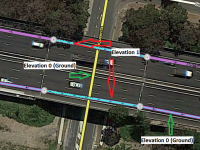Road Names
See this page.
Speed Limits
Each direction of travel on a road can have a speed limit set on it. Waze uses the speed limit to (optionally) warn the driver when they're exceeding the limit. Editors should map the speed limits on roads with the following considerations:
- Map the legal speed limit, not the opinion of the editor e.g. speed limits in car parks.
- Avoid mapping speed limits on roundabouts, as they have no use.
- Do not map advisory speeds, only speed limits.
- Where variable speed limits are in use (such as digital signs, alternate speed when raining, school zones), editors should always map at the higher speed limit.
Elevations
The "Seagull Rule" represents Waze's policy for setting elevation levels. The reason for it is related to the representation of roads, tunnels and bridges in the live map and the app.
We apply the Seagull Rule:
- If a seagull can fly right under it, it’s a bridge (Level 1+).
- Seagulls don't fly underground, these are tunnels (Level -1 and lower)
- For every other case the road is ground level (Level 0), even if it’s artificially elevated or dug under street level.
For example:
- We mark bridges with level = 1.
- We only mark a road as level 2 if there’s another bridge (1) running underneath it.
- Same logic applies for tunnels (in opposite direction), and further (3,4 & -3,-4).
Note:
In many cases we will need to split segments into two or more segments to correctly mark only the right parts of the road as a bridge or a tunnel. (This is important for the map’s fidelity and as cues for drivers)
